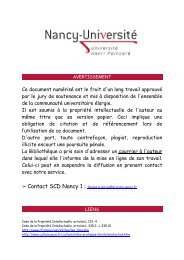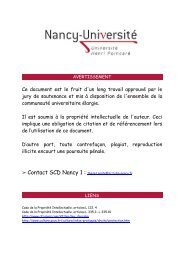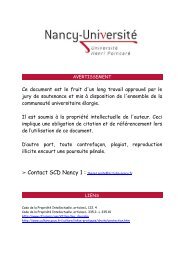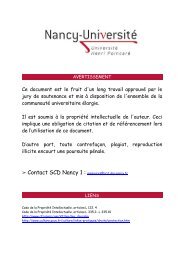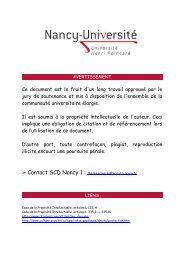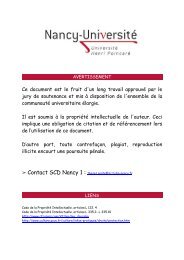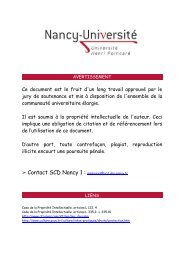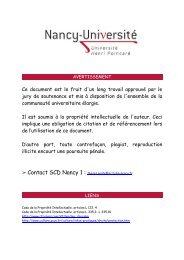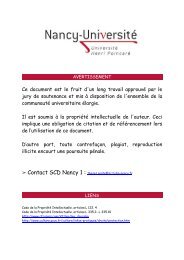Ce document est le fruit d'un long travail approuvé par le jury de ...
Ce document est le fruit d'un long travail approuvé par le jury de ...
Ce document est le fruit d'un long travail approuvé par le jury de ...
Create successful ePaper yourself
Turn your PDF publications into a flip-book with our unique Google optimized e-Paper software.
Tab<strong>le</strong> <strong>de</strong>s matières<br />
1 Champs <strong>de</strong> force et polarisation 1<br />
1.1 Champs <strong>de</strong> force additifs <strong>de</strong> paire . . . . . . . . . . . . . . . . . . . . . . . . 4<br />
1.2 La polarisation explicite <strong>est</strong>-el<strong>le</strong> nécessaire ? . . . . . . . . . . . . . . . . . . 9<br />
1.3 Problématique et objectifs . . . . . . . . . . . . . . . . . . . . . . . . . . . . 14<br />
2 Énergies intermoléculaires 17<br />
2.1 Métho<strong>de</strong>s quantiques . . . . . . . . . . . . . . . . . . . . . . . . . . . . . . . 18<br />
2.1.1 Théorie <strong>de</strong>s perturbations . . . . . . . . . . . . . . . . . . . . . . . . 18<br />
2.1.2 Symmetry-Adapted Perturbation Theory . . . . . . . . . . . . . . . . 20<br />
2.2 Métho<strong>de</strong>s empiriques . . . . . . . . . . . . . . . . . . . . . . . . . . . . . . . 22<br />
2.2.1 Polarisabilités distribuées . . . . . . . . . . . . . . . . . . . . . . . . 23<br />
2.2.2 Charges Fluctuantes . . . . . . . . . . . . . . . . . . . . . . . . . . . 30<br />
2.2.3 Oscillateurs <strong>de</strong> Dru<strong>de</strong> . . . . . . . . . . . . . . . . . . . . . . . . . . 33<br />
3 Développement d’un potentiel intermoléculaire polarisab<strong>le</strong> simp<strong>le</strong> et<br />
précis 37<br />
3.1 Référence quantique utilisée . . . . . . . . . . . . . . . . . . . . . . . . . . . 39<br />
3.1.1 Qu<strong>est</strong>ion sur <strong>le</strong> δHF . . . . . . . . . . . . . . . . . . . . . . . . . . . 39<br />
3.1.2 Analogie entre SAPT et <strong>le</strong> potentiel intermoléculaire . . . . . . . . . 40<br />
3.1.3 SAPT et <strong>le</strong>s molécu<strong>le</strong>s chargées négativement . . . . . . . . . . . . . 41<br />
3.2 É<strong>le</strong>ctrostatique . . . . . . . . . . . . . . . . . . . . . . . . . . . . . . . . . . 41<br />
3.2.1 Effets <strong>de</strong> pénétration . . . . . . . . . . . . . . . . . . . . . . . . . . . 44<br />
3.2.2 Construction du modè<strong>le</strong> é<strong>le</strong>ctrostatique . . . . . . . . . . . . . . . . 46<br />
3.2.3 Interactions é<strong>le</strong>ctrostatiques . . . . . . . . . . . . . . . . . . . . . . . 50<br />
3.3 Induction . . . . . . . . . . . . . . . . . . . . . . . . . . . . . . . . . . . . . 60<br />
3.3.1 Construction du modè<strong>le</strong> <strong>de</strong> polarisabilité . . . . . . . . . . . . . . . . 60<br />
3.3.2 Énergie d’interaction d’induction . . . . . . . . . . . . . . . . . . . . 64<br />
3.3.3 Fonctions d’atténuation . . . . . . . . . . . . . . . . . . . . . . . . . 64<br />
3.3.4 Énergie d’interaction d’induction entre molécu<strong>le</strong>s . . . . . . . . . . . 66<br />
3.4 van <strong>de</strong>r Waals . . . . . . . . . . . . . . . . . . . . . . . . . . . . . . . . . . . 75<br />
3.4.1 Différentes expressions du potentiel <strong>de</strong> van <strong>de</strong>r Waals . . . . . . . . 75<br />
3.4.2 Détermination <strong>de</strong>s <strong>par</strong>amètres <strong>de</strong> van <strong>de</strong>r Waals . . . . . . . . . . . 76



